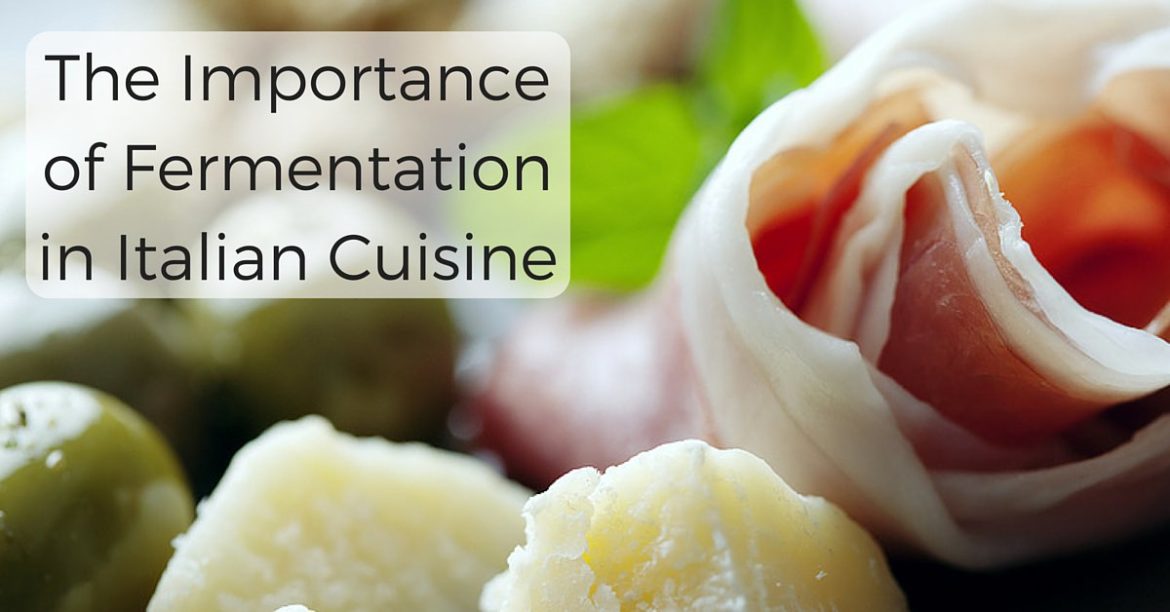- Tomatoes: A Taste of Summer - July 26, 2017
- The International Origins of Pasta - July 12, 2017
- A History of Italian Americans in Salt Lake City - June 29, 2017
The Importance of Fermentation in Italian Cuisine
What is Fermentation?
When you first hear “fermentation” it might not sound like the most appetizing thing. But with a recent rise in specialized food cultures, Americans are learning more about the fermentation process and the benefits it brings.
In Cooked, a documentary on cuisine by food writer Michael Pollan, it is revealed that one-third of the food we eat is fermented, even if we don’t think of it that way. From ketchup to chocolate to hot sauce to salami, these foods undergo a process of chemical change before we consume them. Additionally, in going through the evolution of cuisine, Pollan reveals that people learned to ferment foods long before they even knew what it meant. In fact, fermentation was the primary way that food was preserved for many years.
Fermentation is a “chemical process by which molecules such as glucose are broken down anaerobically…fermentation is the foaming that occurs during the manufacture of wine and beer, a process at least 10,000 years old.” Simply put it, it is a process in which a substance breaks down into a simpler substance.
Today, we’ll take a look at fermentation in Italian cuisine and the health benefits it brings.
Health Benefits of Fermentation
The process of fermentation preserved food and provides us with beneficial enzymes such as B-vitamins, Omega-3 fatty acids, and probiotics (“good bacteria”). The natural fermentation of food preserves nutrients and breaks food down into a more digestible form – hence the link between fermented foods and better digestion.
Probiotics provide our digestive systems with an influx of beneficial bacteria, which has been found to slow or reverse certain diseases, improve our digestion, and also improve our immune systems. Additionally, probiotics help use absorb more nutrients from the foods we eat.
With many foods undergoing industrial processing, there is much less natural fermentation in the average American diet. Luckily, you can find many naturally fermented foods on the Italian table.
Fermentation in Italian Cuisine
Bread
Most bread doughs begin with a yeast starter, a fermentation process that provides us with many health benefits. Fermentation is a crucial step in the bread-making process. In Italian baking, there is a pre-fermentation technique called biga. Biga is at the center of Italian breads such as ciabatta. Biga was developed as bakers in Italy moved away from the use of sourdough. The process of biga provides breads with a complex flavor, after a 12 to 16 hour fermentation process. It also adds to the crisp texture of the crust and an airy, hole-y texture for the insides.
Meat
Prosciutto, salami, parmacotto – these are famous Italian meats that you will find on our menu at Cocina Toscana. These meats fall under the category of a cured meat, which means they are fermented and air-dried.
Italian cured meats are an important branch of Italian cuisine, deriving its production and history for traditional processes of southern and central European peasants.
These meats undergo a process of traditional fermentation, in which raw meats are transformed into edible form after fermentation, ripening, and drying. During the fermentation process, starter cultures are added to the meats. These cultures give dry-cured meats a longer shelf-life and add a complexity of flavor and texture that we find in our favorite Italian meats.
Vegetables
Did you know that brining is a natural fermentation process? Brining involves submerging food items into a mixture of water and salt. The process of brining adds levels of flavor to simple, fresh produce, from peppers to olives to capers.
Balsamic vinegar, with its roots in Reggio Emilia and Modena, Italy, is another example of a fermented product in Italian cuisine. Balsamic vinegar begins with whole peeled grapes – complete with juice, skin, seeds, and stems – that undergo several weeks of natural fermentation and then further maturation. Depending on the wood barrel used, balsamic vinegar takes on the flavors of the casks, whether it is oak, chestnut, juniper, cherry, or mulberry. These add a further depth of flavor to the vinegar.
Come visit at Cucina Toscana, where you’ll experience the depth of flavors of naturally fermented foods throughout our menu!
JOIN US FOR THE FINEST ITALIAN FOOD (AND WINE) IN SALT LAKE CITY
CUCINA TOSCANA
282 S 300 W
SALT LAKE CITY, UT 84101
PHONE: (801) 328-3463

